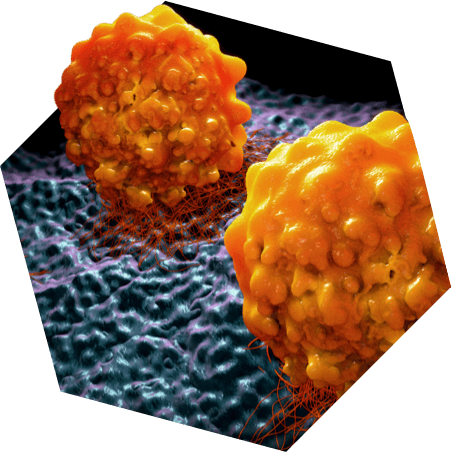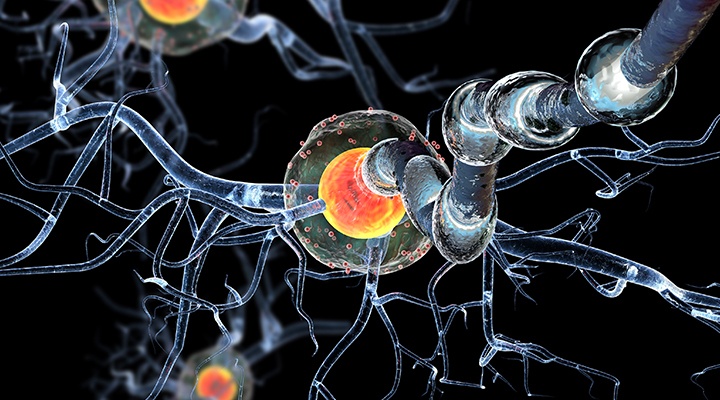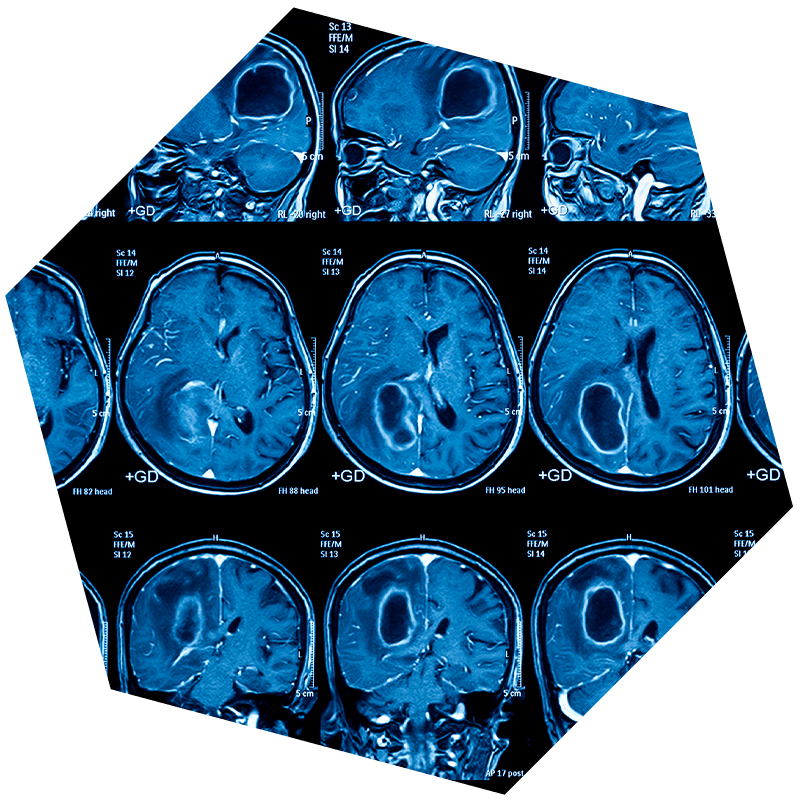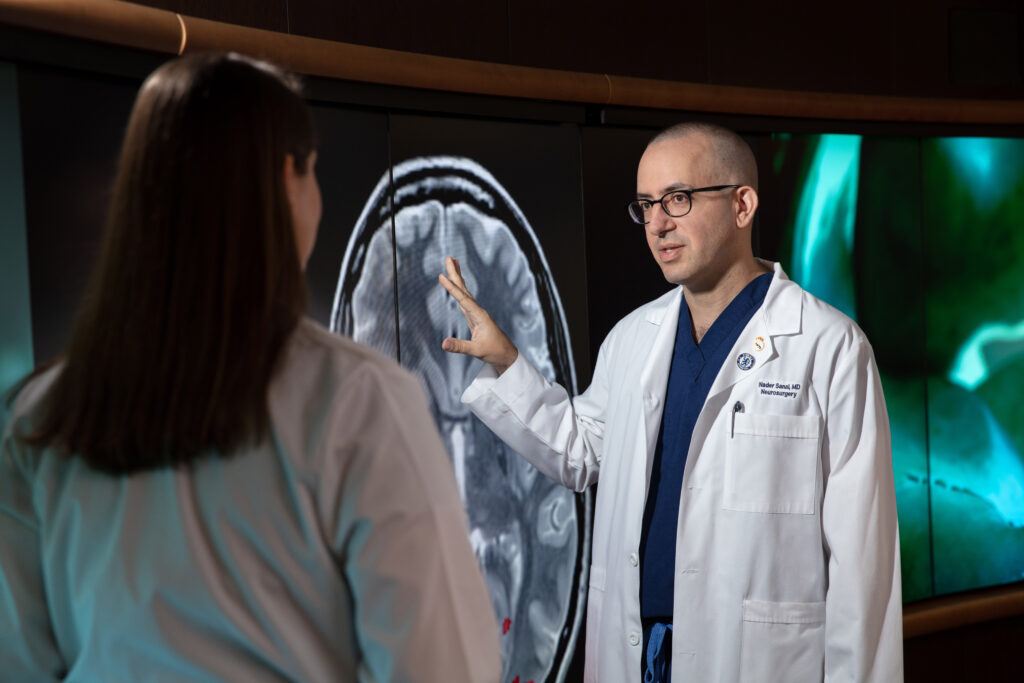
Brain Tumor Types
Brain Tumors: Understanding the Different Types
The brain is an elaborate and sophisticated mass of tissue and nerve cells. It seamlessly controls our personality, senses and movement and helps regulate vital body functions. When cells become abnormal and grow in the brain, a tumor develops. A brain tumor is complex, and no two are alike.
Brain tumors encompass a wide spectrum of types, each with unique characteristics, challenges and treatment considerations. These tumors can vary significantly in their location, behavior and underlying factors. Understanding the different brain tumor types is crucial for accurate diagnosis, treatment planning and improved patient outcomes.

Tumor Diagnosis – How is a brain tumor diagnosed?
Tumor diagnosis may also be referred to as “tumor pathology.” Your neurosurgeon will send a tumor sample to the pathology lab during your surgery. The sample will be examined by a neuropathologist, and a preliminary diagnosis will be determined while you are still in the operating room. This initial diagnosis is also referred to as a “frozen section” diagnosis. It will require more time for testing before a final tumor diagnosis is made. The final tumor diagnosis can take an average of 1-2 weeks after your surgery. For this reason, it is not uncommon to be discharged from the hospital before you receive information on your final tumor diagnosis. Your neurosurgeon or oncologist will discuss your tumor diagnosis at your postoperative office visit.
Brain Tumors We Treat
The Ivy Brain Tumor Center is focused on discovering new treatment options for aggressive brain tumors that often respond poorly to the standard of care or recur after treatment. Click below to learn more about the tumors we treat in our robust clinical trials program.

GLIOMAS
Gliomas are ‘primary’ brain tumors, which means they are derived from the brain tissue itself.

BRAIN METASTASES
Brain metastases, or ‘secondary’ brain tumors, originate from cancer in another part of the body.

MENINGIOMAS
Meningiomas are ‘primary’ brain tumors. They are derived from the lining of the brain (known as the meninges).

Primary Brain Tumors: Originating in the Brain
Primary brain tumors start in the brain. Typically, they are described by a neuropathologist by the way they look under a microscope, using the World Health Organization (WHO) grading scale from 1 to 4:
- Grade 1: Slow-growing tumor cells; almost normal appearance; least aggressive; often curable by surgery alone; rarely recur as a higher grade
- Grade 2: Relatively slow-growing cells; slightly abnormal appearance; can invade nearby tissue; may recur as a higher grade
- Grade 3: Actively growing cells; abnormal appearance; infiltrates normal tissue; also referred to as “anaplastic tumors”
- Grade 4: Rapidly reproducing abnormal cells; very abnormal appearance; area of dead cells (necrosis) in center
Glioblastoma
Glioblastoma is a high-grade glioma. Glioblastoma is the most aggressive, treatment-resistant and most common type of primary brain tumor. These tumors begin in the glial cells, specifically the astrocytes.
High-Grade Glioma
High-grade gliomas are tumors that grow from the cells that make up the brain tissue. The higher grade means the tumor is more aggressive than a lower-grade tumor. Types of these tumors include astrocytoma, oligodendroglioma and glioblastoma. Treatment is surgery followed by combined radiation and chemotherapy. Treatment in a clinical trial may also be offered.
There are many types and subtypes of primary brain tumors, some can be slower growing, and some grow more aggressively and can spread to other parts of the nervous system, though rarely to other organs. The following is a list of primary brain tumors and their treatments:
Low-Grade Glioma
Low-grade gliomas (grade 2) include astrocytomas and oligodendrogliomas. Treatment after surgery may include radiation or chemotherapy. If these tumors are not considered high risk, growing rapidly or causing symptoms, sometimes they will just be observed without other treatment. Treatment in a clinical trial may also be offered. For very low-grade gliomas (grade 1) such as Juvenile pilocytic astrocytomas, which grow from cells that make up brain tissue, surgery alone is generally the treatment but is sometimes followed by radiation and chemotherapy if complete resection is not achieved.
Astrocytoma
An astrocytoma is a tumor arising from mutated or damaged astrocytes – star-shaped glial cells in the brain. Astrocytomas can range from grade 1, juvenile pilocytic astrocytoma, to grade 4, also called glioblastoma. Treatment for these tumors varies and typically consists of surgery, radiation and chemotherapy.
Oligodendroglioma
Oligodendrogliomas are primary central nervous system (CNS) tumors, meaning they begin in the brain or spinal cord, originating from glial cells called oligodendrocytes. Oligodendrogliomas are commonly found in the white matter and the outer layer of the brain, called the cortex, but can form anywhere in the CNS.
Diffuse Midline Glioma
Beginning in the brain or spinal cord, diffuse midline gliomas are primary central nervous system (CNS) tumors. All diffuse midline gliomas are grade 4 tumors, which means they are cancerous and fast-growing.
Primary central nervous system lymphoma
Primary central nervous system (CNS) lymphoma originates from lymphocytes (a type of white blood cell) in the brain. Primary CN lymphoma is malignant, but with correct treatment, it can be cured with chemotherapy. In some cases, it’s also treated with radiation therapy.
Meningioma
Meningiomas grow from the lining of the brain and are graded 1, 2 or 3. Grade 1 is the most common type and is generally treated with surgery alone. Grade 2 meningiomas, also referred to as atypical meningiomas, are less common and are treated with surgery followed by radiation in most cases. Grade 3, also known as anaplastic meningiomas, is rare and more aggressive. Therefore, treatment includes surgery followed by radiation. Grade 2 and 3 meningiomas can recur. Chemotherapy may be considered for aggressive and recurrent meningiomas. Clinical trials offer patients access to experimental treatments for this type of brain tumor.
Ganglioglioma
Ganglioglioma and gangliocytomas are tumors that come from cells or nerves that comprise brain tissue. They are not very common in adults and generally are grade 1 but rarely can be malignant. Treatment for low-grade tumors is surgery alone. Radiation may be required for higher grade or an incomplete resection of a low-grade tumor.
Schwannoma
Schwannomas are tumors that come from the nerve cell, most commonly the vestibular nerve, which can affect hearing. The tumors are usually very slow growing, but, depending on the location, they can cause compression of surrounding structures such as the brainstem, nerves or spinal cord. Treatment is surgery and/or radiation therapy.
Ependymoma
Ependymomas grow from ependymal cells, specific glial cells that line the ventricles. Treatment of low-grade ependymoma is surgery alone. Treatment for higher-grade ependymoma will likely involve radiation after surgery. Chemotherapy may be considered for aggressive and recurrent diseases.
Subependymoma
Subependymomas grow from the lining of the ventricles. Surgery alone is generally the treatment. These are usually low-grade tumors.
Hemangioblastoma
Hemangioblastomas are tumors that come from blood vessel cells. The most common location is the cerebellum. They are generally low-grade tumors. Treatment is surgery, possibly followed by radiation if the entire tumor is not removable.
Pineal-Region Tumor
Pineal tumors come from the pineal gland in the center of the brain. Pineal gland tumors are rare, and several types can arise from the pineal gland, requiring different treatments.
Medulloblastoma
Medulloblastomas are tumors that come from undeveloped cells in the cerebellum. These tumors are malignant, but with correct treatment, can be cured. These tumors usually occur in children and rarely in adults.
Pituitary adenoma
Pituitary adenomas grow from the pituitary gland. Some, but not all, tumors secrete hormones. Treatment is usually surgery. Radiation may be recommended if the tumor cannot be safely removed with surgery or if the tumor grows back after surgery. Other doctors who are experts with hormones will also be part of your care.
Craniopharyngioma
Craniopharyngiomas come from pituitary gland embryonic tissue. They are benign tumors. These tumors are more common in children but also affect adults. Treatment is surgery, and radiation is used sometimes if the entire tumor is not removed.

Metastatic Brain Tumor: Spreading from Other Organs
Metastatic tumors of the brain are tumors or cancers that have spread from another part of the body. Metastatic tumors are the most common brain tumor. The most common cancers that spread to the brain are lung, breast, renal, melanoma and colon. These tumors are usually treated with surgery that is sometimes followed by radiation or stereotactic radiosurgery, such as Gamma Knife or CyberKnife.
Symptoms Based on Brain Tumor Location
Each area of the brain is responsible for a different function. While symptoms can vary from patient to patient, many of the symptoms a brain cancer patient experiences directly correlate to the location of their tumor. Here is a breakdown of the brain’s functions based on location and the corresponding symptoms a brain tumor patient may experience. If you are encountering any of these symptoms, please contact your physician.
Frontal Lobe – Cognitive and motor functions
Weakness, paralysis on one side of the body, mood disturbances, difficulty thinking, confusion, disorientation, mood swings, problems with speech output, seizures
Parietal Lobe – Processing sensory information
Seizures, paralysis, problems with handwriting, mathematical difficulty, motor skill deficits, loss of sense of touch
Occipital Lobe – Visual perception
Loss of vision, visual hallucinations, seizures
Temporal Lobe – Processing memories
Seizures, perceptual/spatial disturbances, inability to understand language, receptive aphasia or incoherent speech
Cerebellum – Balance and coordination
Loss of balance (ataxia), loss of coordination, headaches, vomiting, dizziness
Hypothalamus – Regulating the body’s automatic functions
Emotional changes, deficits in perception of temperature, problems with growth/nutrition (in children)

Brain Tumor Care at the Ivy Brain Tumor Center
The Ivy Brain Tumor Center remains dedicated to advancing brain tumor treatment through cutting-edge research and unparalleled patient care. As we strive to unravel the complexities of brain tumors, ongoing research and clinical trials offer hope for improved diagnostics, treatment options and patient outcomes.
By understanding the distinct types of brain tumors and their nuances, healthcare professionals, patients and their families can navigate the journey with greater knowledge, optimism and resilience. Together, we can continue to make strides in the fight against brain tumors, fostering a brighter future for all those affected by these challenging conditions.



